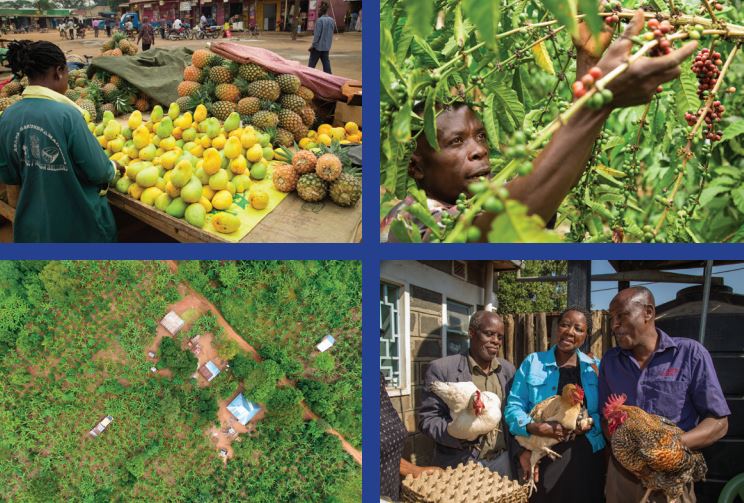On October 15, 2018, the World Bank published a report titled Scaling Up Climate-Smart Agriculture through the Africa Climate Business Plan. A synopsis appears below, with a link to the full report.
Climate change and food insecurity are the twin development challenges that may define Africa’s future. More than 240 million, or one in five, people are undernourished in the continent, and the number could increase to 350 million by 2050 if appropriate adaptation measures are not taken to cope with the intensity of future climate change.
 The Africa Climate Business Plan (ACBP) was launched by the World Bank at the 21st Session of the Conference of the Parties (COP 21) in Paris in 2015 to address Africa’s intricately linked climate and development agendas. The ACBP calls for US$19 billion in funding to help Africa adapt to climate change and build up the continent’s resilience to climate shocks.
The Africa Climate Business Plan (ACBP) was launched by the World Bank at the 21st Session of the Conference of the Parties (COP 21) in Paris in 2015 to address Africa’s intricately linked climate and development agendas. The ACBP calls for US$19 billion in funding to help Africa adapt to climate change and build up the continent’s resilience to climate shocks.
The ACBP includes a focus on climate-smart agriculture (CSA), an integrated approach that aims to address the interlinked challenges of food security and climate change by sustainably increasing agricultural productivity to support equitable increases in farm incomes, food security, and development; adapting and building resilience of agricultural and food systems to climate change at multiple levels; and reducing greenhouse gas (GHG) emissions from agriculture.
The assessment of the progress in implementing CSA under the ACBP was carried out against the background of the extent to which African countries have adopted CSA policies and created the enabling environment for implementation. The set of CSA policy indicators developed by the World Bank assesses the enabling environment, that is policy and institutional frameworks, readiness mechanism, services and infrastructure, and coordination mechanism within a country supporting the implementation of CSA.
African countries scored low on the CSA Policy Indicators, especially Readiness Mechanism, Services and Infrastructure, and the Aggregated Policy Index. This indicates that they face critical challenges related to leveraging investments for climate action, promoting adoption of new technologies, providing enabling services, and creating the necessary institutions for CSA implementation.
A key contribution to the low Readiness Mechanism scores is the lack of monitoring and implementation systems to support adaptation and mitigation policies in many African countries. The low average score of the Services and Infrastructure results from the inadequacy of critical CSA enablers—such as well-functioning agricultural extension system, poor access to input and output markets, inefficient agricultural risk management system, and scarce social safety nets—that are critical for promoting the adoption of CSA.
South Africa with its strong agricultural export markets is a top performer (Aggregated Policy Index of 77 percent) because its agricultural sector is supported by market information systems, agriculture crop insurance, warehouse receipts systems, and early warning systems (EWSs) for weather and pest management that are critical for well-functioning markets. The country also is able to leverage investments for the adoption of new technologies through significant public investments in research and development (R&D). Tanzania’s relatively high score (Aggregated Policy Index of 76 percent) is driven, among others, by strong coordination mechanisms.
Tanzania’s commitment to addressing climate adaptation and mitigation in the agriculture sector is reflected in the country’s National Climate Change Strategy. A multi-sectorial approach facilitated by the National Climate Change Technical Committee (NCCTC) and National Climate Change Steering Committee (NCCSC) is used to support CSA. Rwanda is another top performer (Aggregated Policy Index of 73 percent) with a dedicated Strategic Program for Climate Resilience (SPCR). The country also has established public-private partnerships to develop services and infrastructure, such as crop insurance for CSA. Compared to others, Rwanda scores high in agricultural adaptation policy, agricultural mitigation policy, agricultural R&D, social safety nets, national GHG inventory system, and disaster risk management coordination.
The bottom performers on the CSA Policy Index in Africa include Sudan (with Aggregated Policy Index of 31 percent), Central African Republic (36 percent), and Equatorial Guinea (37 percent). The countries are among the top five oil-producing countries in the region with economies heavily dependent on oil revenues and the agricultural sector critically underdeveloped. Most of the low performers have poorly developed or no National Adaptation Plan of Actions (NAPAs), for example, to support CSA implementation. The lack of diversification in the economy and underdevelopment of the agriculture sector has accounted for weak institutional mechanism and enabling environment for CSA.
Sudan, however, is taking steps to create a stronger enabling environment. For example, through the Agricultural Revival Program (ARP) launched in 2008, the country aims to address structural weaknesses in the sector, and many of the priority areas of intervention coincide with the NAPA objectives. Also, there are some services in place with the potential to create a strong enabling environment for CSA, such as the Sudanese Food and Agriculture Market Information System, which collects and disseminates crop, livestock, and horticultural and animal products prices to market participants. Sustained commitment to improved agricultural policies, consistent approach, and better coordination is essential to develop a transformational agenda for agriculture in Sudan.

